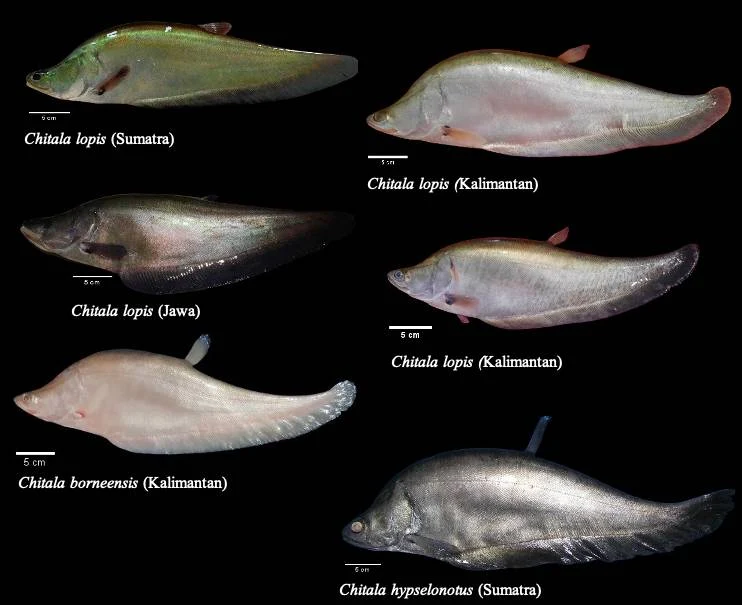Rare Extinct Fish Rediscovered on Java Island: Unraveling the Mystery Behind Indonesia's Giant Featherback Fish!
Once declared extinct in 2020, the Chitala lopis (C. lopis), commonly known locally as Belida fish or the Giant Featherback fish, has been rediscovered in Java, Indonesia. This Belida species was last spotted on the island 172 years ago, specifically in 1851. The discovery extends the known presence of C. lopis to three islands: Java, Sumatra, and Kalimantan.
Furthermore, a collaborative research effort involving the National Research and Innovation Agency (BRIN), the Food and Agriculture Organization, Yayasan Selaras Hijau Indonesia, Jambi University, Charles Sturt University of Australia, Vienna Museum of Austria, and Montpellier University of France has also shed light on the taxonomic issues surrounding the Chitala genus in Indonesia.
Chitala lopis is a species of freshwater fish, endemic to the islands of Java and Sumatra in Indonesia. It inhabits lowland river mainstreams and tributaries with rocky and sunken wood bottoms, as well as forest-covered streams. It feeds on smaller fishes, insects, and vertebrates, mostly at night. It grows up to a length of 1.5 m (4.9 ft). Other well-known related species are the clown knifefish (C. ornata) and the Indochina knifefish (C. blanci).
Belida fish has long been renowned in Indonesia as a key ingredient for specialty dishes like Empek-empek and Kerupuk. This freshwater fish is not only delicious but also holds significant economic value. Beyond its culinary uses, Belida is also cherished as an ornamental fish due to its captivating colors and distinctive patterns.
In 2020, the International Union for Conservation of Nature (IUCN) Red List declared the extinction of C. lopis on Java Island. The rediscovery of this belida fish stems from collections gathered between November 2015 and September 2023 across 34 locations in Java, Sumatra, and Kalimantan.
Following a comparison of DNA barcoding sequencing data with the global Barcode of Life Data (BOLD) and morphological characterization against specimens of Chitala lopis housed at the Natural History Museum in London, the research team concluded that the species in question is indeed C. lopis.
The validity of this discovery was published in a highly reputable German journal, the Journal of Endangered Species Research, Volume 52, in November 2023.
Arif Wibowo, a researcher and Head of the Center for Conservation Research on Marine and Freshwater Resources at BRIN involved in the discovery, revealed that the species, belonging to the Family Notopteridae and Order Osteoglossiformes, is an ancient fish characterized by its fan-like fin shape.
"Upon intraspecific examination, the genetic distance between C. lopis, C. hypselonotus, and C. borneensis is remarkably low, indicating that the mitochondrial gene differentiators among these species are not identical. Morphologically, C. lopis exhibits a more dominant posterior body height and pre-dorsal length compared to C. borneensis. The evolution of C. lopis is estimated to have occurred around 1,200 years ago," Arif explained.
Not only does this discovery refute the extinction of C. lopis, but it also addresses taxonomic concerns surrounding belida fish in Indonesia. According to experts, the majority of belida fish in Indonesia fall under the C. lopis species. However, other frequently encountered types include C. borneensis and C. hypselonotus.
"The abundance and distribution of these three fish species have declined on the islands of Sumatra and Java. In fact, the last sighting of C. hypselonotus was recorded in 2015," he added.
According to Indonesia's Minister of Marine Affairs and Fisheries Regulation No. 1 of 2021 concerning Protected Fish Species, there are four species from the Notopteridae family that are protected, three of which are C. lopis, C. borneensis, and C. hypselonotus.
The IUCN indicates that the Chitala species falls under the "Least Concern" category in terms of extinction risk in Indonesia, except for C. lopis, which was considered extinct.
Therefore, the conservation status of the IUCN needs reevaluation, not just for C. lopis in Java but also across its distribution in Indonesia. There's also a pressing need to revise the conservation status of C. hypselonotus and C. borneensis from "Least Concern" to "Critically Endangered" due to limited stocks and distribution.

Post a Comment